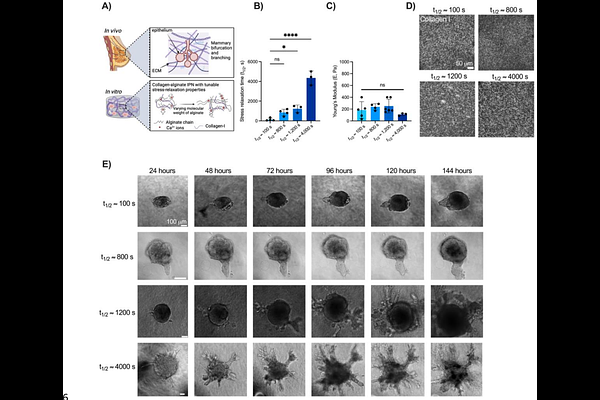Extracellular matrix viscoelasticity regulates mammary branching morphogenesis

Extracellular matrix viscoelasticity regulates mammary branching morphogenesis
Walter, D. I.; Moore, J. W.; Sharma, A.; Stowers, R.
AbstractStructural and mechanical cues from the extracellular matrix (ECM) regulate tissue morphogenesis. Tissue development has conventionally been studied with ex vivo systems where mechanical properties of the extracellular environment are either poorly controlled in space and time, lack tunability, or do not mimic ECM mechanics. For these reasons, it remains unknown how matrix stress relaxation rate, a time-dependent mechanical property that influences several cellular processes, regulates mammary branching morphogenesis. Here, we systematically investigated the influence of matrix stress relaxation on mammary branching morphogenesis using 3D alginate-collagen matrices and spheroids of human mammary epithelial cells. Slow stress relaxing matrices promoted significantly greater branch formation compared to fast stress relaxing matrices. Branching in slow stress relaxing matrices was accompanied by local collagen fiber alignment, while collagen fibers remained randomly oriented in fast stress relaxing matrices. In slow stress relaxing matrices, branch formation was driven by intermittent pulling contractions applied to the local ECM at the tips of elongating branches, which was accompanied by an abundance of phosphorylated focal adhesion kinase (phospho-FAK) and {beta}1 integrin at the tips of branches. On the contrary, we observed that growing spheroids in fast stress relaxing matrices applied isotropic pushing forces to the ECM. Pharmacological inhibition of both Rac1 and non-muscle myosin II prevented epithelial branch formation, regardless of matrix stress relaxation rate. Interestingly, restricting cellular expansion via increased osmotic pressure was sufficient to impede epithelial branching in slow stress relaxing matrices. This work highlights the importance of stress relaxation in regulating and directing mammary branch elongation.